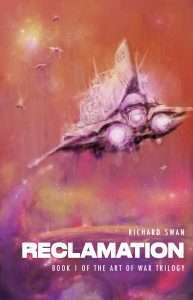Project Starship: Materials Engineering Challenges in Science Fiction
Part of the delight in reading science fiction is seeing how real science can be extrapolated to envision future technologies, whether here on Earth or in extraterrestrial environments. Starships are a ubiquitous presence in science fiction and a prototypical example of technology that can stimulate the imagination of future scientists and engineers. As a materials scientist, I am particularly intrigued by the role of various materials (metals, ceramics, glasses, polymers, nanomaterials, etc.) in building the starships of tomorrow.
The purpose of this science-meets-science fiction initiative, which we are calling Project Starship, is to deepen the connection between the scientific and science fiction communities, helping to stimulate new interest in both fields. To kick off this series of articles, Grimdark Magazine reached out to three leading voices in dark science fiction to explore the materials required for designing the starships from within their fictional universes. First up is Graham McNeill, a British novelist best known for his Warhammer 40k novels, including Nightbringer. Next is Richard Swan, critically acclaimed author of the dark science fiction trilogy, The Art of War. Finally, Essa Hansen is author of the dark science fiction series, The Graven, which begins with the critically acclaimed Nophek Gloss.
The Anatomy of a Starship What starships are featured in your sci-fi universe, and what are the technical requirements they need to meet?
What starships are featured in your sci-fi universe, and what are the technical requirements they need to meet?[Graham McNeill] Most of the Imperial starships in 40k are ancient vessels that have plied the gulfs of space for thousands of years and are relics of many lost technologies. They’re gothic masterpieces of cathedral-like command decks, flying buttresses, arches, and temples, many kilometres in length, crusted with centuries of debris and micro-impacts. Their primary technical requirement is to be armoured enough to take punishing barrages as they plunge headlong into enemy formations and to survive traveling through the hell-dimension of the Warp.
[Richard Swan] Largely warships. They must be strong enough to accelerate to incredible speeds and withstand the high inertial forces of turning sharply in three dimensions; they also need to be able to withstand enemy fire (both solid shot and directed energy) and collisions with particulate space debris at near-relativistic speeds. And, naturally, they have to house human beings, weapon systems, electronic warfare systems, et cetera.
[Essa Hansen] The world of The Graven series is unrelated to Earth and leans to the fantastical side of science fiction, meaning I had the luxury of a lot of hand-waving on the technical side. The series world is a bubble multiverse: various-sized bubble-shaped universes stuck together or embedded within one another, with membrane borders, and a different set of physical laws within each universe. The difference in physics might be negligibly slight (small adjustments in this or that math) or wildly and dangerously different (the behavior of the world breaks down as we know it). The easiest way to visualize this is through physical materials and elements transforming, distorting, or breaking down as they pass through the membrane and adjust to the parameters of the new universe. The economy of the multiverse revolves around exploration, trade, and trans-universal transformation, so starships are essential, and being able to travel widely comes down to the particular materials and construction of one’s ship.
The multiverse also features a wide diversity of alien species, which I imagined would have unique designs and materials for their ships, especially in ways that might accommodate non-human biology. For example, what would a space-faring ship look like for an entirely aquatic species?
 What are some of the materials required to build these starships?
What are some of the materials required to build these starships?[Graham McNeill] Most Imperial ships are built from stone, steel, ceramite, and adamantium: materials that are tough enough to withstand a void-battle and endure travel through the Warp. Ceramite is a kind of amalgam of high-strength steel that is all but immune to heat, which certainly helps when you’re up against alien fleets with plasma weaponry.
[Richard Swan] The ships have 3 layers of shielding to meet these requirements: kinetic force shields, a sort of nebulous cloud of particles that accrete instantaneously when disturbed by objects travelling over a certain speed; nanoform composite ablative armour, which forms the primary physical barrier; and a nanogel non-Newtonian fluid shock dissipater that sits under the outer skin and which absorbs the kinetic energy of anything that makes it through the first two layers.
In terms of materials, I wouldn’t even know where to begin with the force shield—such technology feels a century off at least. As for the latter two, strong but ultra lightweight materials are being created all the time (e.g., graphene), and polymerisation techniques are evolving at incredible speeds. As for the fluids, shear thickening fluids and magnetorheological fluids are both currently being researched by Western defence agencies for advanced forms of body armour. Therefore, it’s not so much a question of new technologies, but refining existing ones.
[Essa Hansen] In this bubble multiverse, there would be universes where it’s possible to have ships with contemporary, non-fantastical materials, but they would be confined to operating within those compatible universes. To have access to the widest range of universes—and thereby, the most personal and economic opportunity—means a starship with materials that are resilient and durable enough to withstand various and repeated translations in physical parameters. I imagined that successful materials would have to be malleable in some way, even organic—versus the rigid forms we commonly see in sci-fi—able to change in structure or in phase to accommodate potentially extreme fluctuations of environment.
One example of such fantastical material is the “Glasliq” ship in the story, conceptualized as being skinned/muscled in a sort of liquid glass or liquid crystal attached around a frame that can fold or give. This alien liquid glass can change phase between liquid, solid, and a cloud of particulates, and take on specific forms sort of like how a ferrofluid changes to magnetic fields. The ability to take on transformations without losing integrity makes the ship resilient to universe changes, lets it pass through obstacles and apertures of various size, and can alter its aerodynamics.
Unless there were a set of ideal materials for trans-universal travel, I think most ships would suffer pros and cons unique to each universe: some materials/construction function better while some things fare worse. This would shift with every new universe. Maybe the electrical system works here, but the armor is brittle. Maybe here we don’t have oxygen, but the artificial gravity is better. Only the titular Azura starship of the series is able to create a small universe of its own around it, bubbling it in constant ideal parameters for its materials. With those physics applied, the sound and function of it described as smoother and more organic, the rigidity and buzzes and separation between components soothed.
 What are the greatest technical challenges for turning the starships of your sci-fi universe into reality?
What are the greatest technical challenges for turning the starships of your sci-fi universe into reality?[Graham McNeill] When 40k ships travel between the stars, they do it through the Warp, a hellish dimension of madness that exists out of time and space, and which is inhabited by all manner of diabolical creatures formed from the subconscious desires and emotions of mortals, so a pretty nasty place overall. To start with, they’d need engines capable of breaching the walls of reality and space/time to ‘translate’ into the Warp. And once they arrive, for a ship to survive, it needs a Geller Field, which is an energy shield that keeps out the immaterial creatures of the warp. Without that, a ship would be overrun almost as soon as it entered the Warp as the hellish monsters can pass through the ship’s armour in the blink of an eye to turn its crew into possessed monsters, drive them mad or otherwise corrupt them in all the worst ways possible.
[Richard Swan] I think creating an armed and armoured spacecraft is very much already possible with current technology. What is lacking is the need, desire, and funding. Indeed, the crew compartments of the International Space Station are already armoured with double-walls, designed to shatter and absorb debris of up to a few mm in diameter. For the ships of my own books, the real impossibility is the FTL drives and communications arrays. Everything else is simply a more advanced version of the technology we already have. Of course, in the actual future, I suspect that almost every military spaceship will be entirely robotic / remote piloted.
[Essa Hansen] As most of the starships in my multiverse are designed to be able to accommodate a wide range of worlds, including ones like ours, they would probably do fine in our reality! They would just be in the tamest possible form, without the wild features that make sci-fi such a fun playground for the imagination.
Materials Considerations in Starship DesignThe materials used in starship design reflect both the technological constraints and advancements within each author’s universe. Starship design in Graham McNeill’s Warhammer 40k novels begins with well-established real-life materials like stone and steel, but also includes realistic extrapolations of new materials like ceramite. Some of the important properties of this ceramite include high thermal conductivity to rapidly dissipate heat from high-energy enemy attacks, as well as high mechanical strength and toughness. Overall, ceramite reflects a conceivable combination of properties based on our known materials science.
 As a metallic alloy that is nearly impermeable to enemy attacks, adamantium is more of a stretch, but still not impossible. Recent development of metallic glass alloys, for example, offers a glimpse of the future of high-performance materials design within the field of metallurgy. The Warhammer 40k universe also features composites of ceramite and adamantium, combining the best properties of these materials to make armor with incredibly high strengths.
As a metallic alloy that is nearly impermeable to enemy attacks, adamantium is more of a stretch, but still not impossible. Recent development of metallic glass alloys, for example, offers a glimpse of the future of high-performance materials design within the field of metallurgy. The Warhammer 40k universe also features composites of ceramite and adamantium, combining the best properties of these materials to make armor with incredibly high strengths.
Composites are also central to Richard Swan’s universe, enhancing material performance by combining the best features of different types of types of polymers, metals, ceramics, etc. Swan goes beyond solid materials, also emphasizing the unique flow properties of fluids and gels, capable of dissipating energy without fracture. Fluids are particularly interesting since they can flow, but they can never be broken.
Materials must withstand the test of time, especially in the Warhammer 40k universe, where much of the relevant engineering knowledge has been destroyed or forgotten. Interestingly, the starship designs in Graham McNeill’s novels are not purely utilitarian: there is also an artistic component to their cathedral-like design, lending a sense of reverence for these marvels of lost technology. Of course, warships must withstand all types of enemy assaults, whether mechanical, thermal, or electromagnetic in origin. The physical laws governing such assaults are especially complicated in Richard Swan’s universe, since as warships approach the speed of light, relativistic effects lead to changes in the passage of time and the apparent mass of the materials making up the vehicle.
Essa Hansen raises an intriguing question of what happens to materials when there are slight changes in physical constants, e.g., when jumping between different universes. Even small variations in what we believe to be universal physical constants (like Boltzmann’s constant or Planck’s constant) could completely change the structure of atoms and how they bond to each other when building different types of materials. Hansen’s novels, therefore, pose unique requirements for multiverse travel beyond anything ever considered in real-life materials design.
I am particularly intrigued by the Glasliq material in Essa Hansen’s multiverse. Real-life glasses combine properties of both liquids and solids. Phase change materials that convert among liquid, crystal, and glassy phases have been critical in the real-life design of rewriteable memory storage. Hansen’s phase change to “cloud of particulates” may be more challenging, but many of the other properties of Glasliq are already within reach.
Altogether, starships from our favorite grimdark science fiction books involve addressing challenges across materials chemistry, physics, and engineering. Our series will continue in future issues of Grimdark Magazine, where we will take a deeper dive into how real materials could be extended to achieve the demanding performance requirement of the spacecrafts of tomorrow. The next article in this series will focus on glass science and technology, understanding how strengthened glass can be developed to offer optical clarity and protection against high-stress mechanical impact. We’ll also explore the science behind phase change materials, such as the Glasliq material used by Essa Hansen in her sci-fi universe. In the following issue of the magazine, Dr. Lourdes Bobbio from Penn State University will share her thoughts on metallurgy in starship design.
This article is published in Grimdark Magazine #40.
The post Project Starship: Materials Engineering Challenges in Science Fiction appeared first on Grimdark Magazine.



